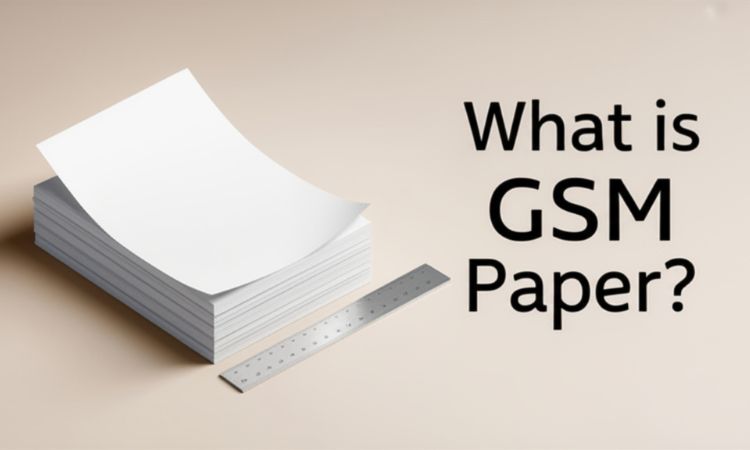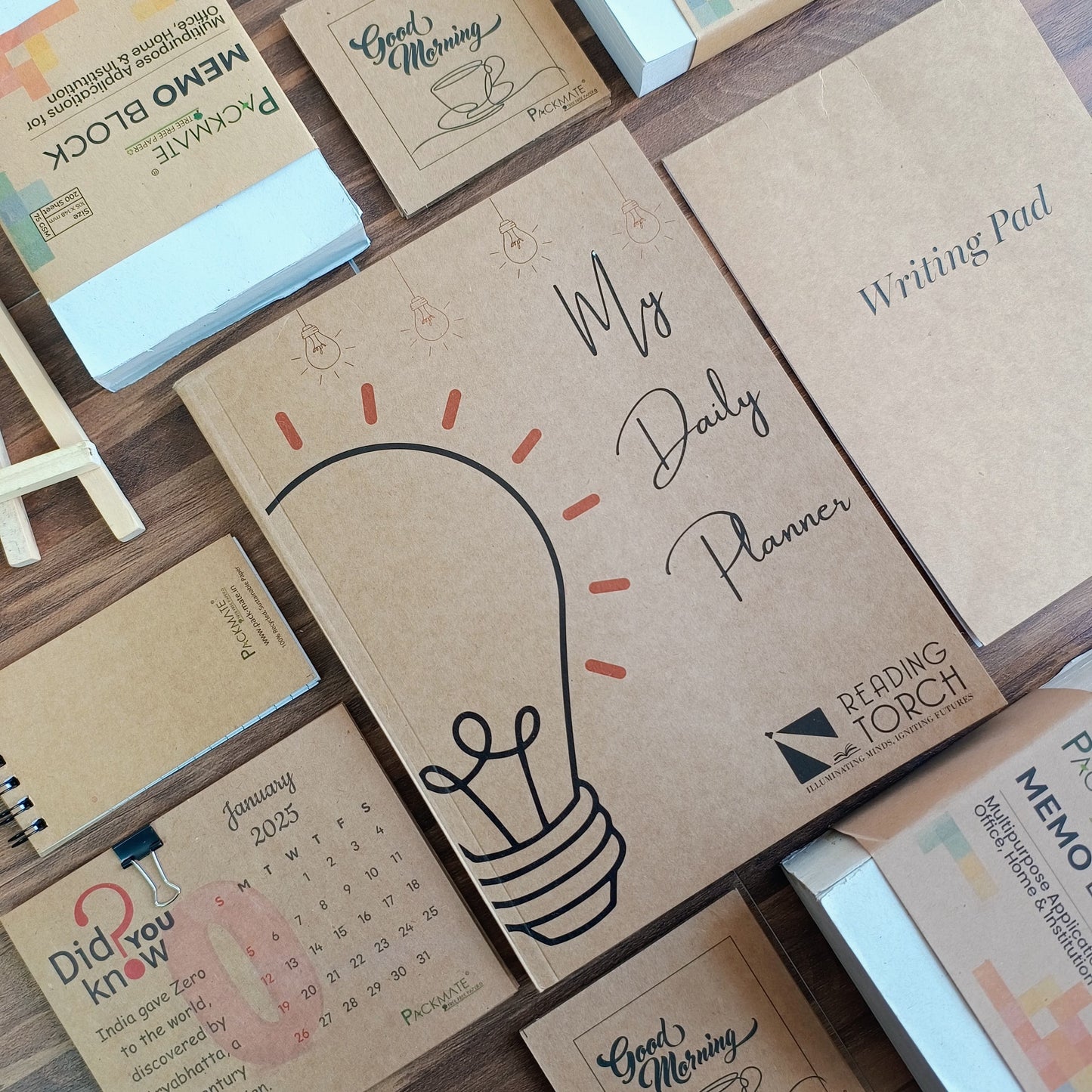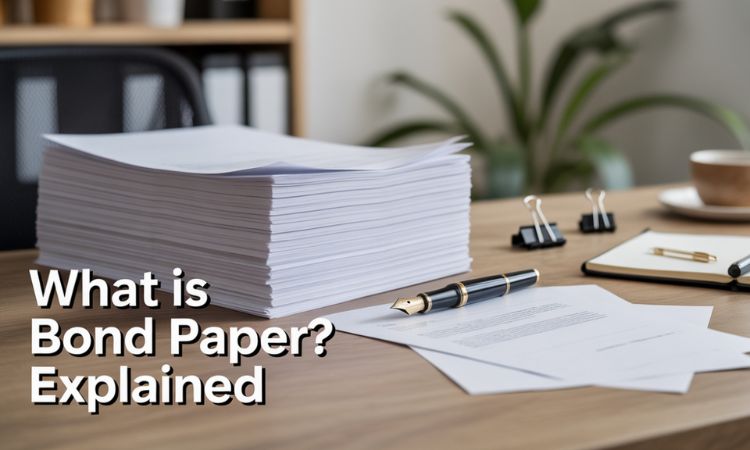
You may have noticed that the papers used in official work feels heftier or sturdier than others? Have you ever been curious about the significance of numbers such as 80 GSM or 300 GSM appearing on a ream of paper?
There are so many people who have no idea about what is GSM paper. There are thousands of varieties of paper, each with a unique set of properties. GSM full form in paper is grams per square meter which is measurement for thickness and weight of a paper. The higher the GSM number, the heavier the paper will be.
In this guide, you'll learn about the GSM Paper, its meaning, importance and how it helps you to select the right paper for your needs, be it for writing, printing, packing, the list goes on.
What Does GSM Stand For in Paper?
GSM, which means Grams per Square Meter, tells you the thickness and weight of the paper. It is important to know about GSM because it helps you pick the right paper for your situation- printing documents, drawing, card making or even packing.
GSM paper is a map through which we can understand the thickness and strength of the paper. If you are choosing paper for business cards, notebooks, then it may be necessary to know about GSM.
Print on thick paper looks clear and professional, whereas printing on light paper may not be as durable or elegant. Paper with low GSM can be thin and flexible like common printing paper. Paper with high GSM is thick and strong, like cards or invitations.
Why Does GSM Matters in Paper Selection?
GSM is an important factor in paper selection because it shows the thickness and quality of the paper. Paper with a higher GSM is thicker and stronger. This is important in printing, packaging, and other applications where paper strength and durability are important.
Paper with higher GSM absorbs ink better, making prints clearer and vibrant. Paper with lower GSM has higher transparency, while paper with higher GSM has less transparency.
Types of GSM Paper
Here are the types of GSM paper:
-
35-55 gsm paper: This is the thinnest paper, usually used for newspapers and tracing papers.
-
70-100 gsm paper: This is used for general office paper and stationery.
- 100-120 gsm paper: This is used for letterheads and other note paper sheets.
-
130-250 gsm paper: This is used for flyers, posters, and other promotional materials.
-
300+ gsm paper: This card stock is used for business cards and other high-quality papers.
-
400 gsm paper: This is a strong and thick paper. It is commonly used for business cards.
Common GSM Paper Ranges and Their Uses
Papers of different GSM ranges are used for different purposes. They range from 750 GSM to 350 GSM. From given table, you will know more about them:
| GSM Range | Description | Common Uses |
|---|---|---|
| 35–55 GSM | Very thin, lightweight paper | Newspapers, tracing paper, tissue wrap |
| 70–90 GSM | Standard lightweight office paper | Everyday printing, A4 paper ream |
| 90–120 GSM | High-quality office paper | Letterhead paper, presentations, resumes |
| 120–170 GSM | Mid-weight paper | Posters, flyers, certificates |
| 170–250 GSM | Thick paper, almost card-like | Premium brochures, menus |
| 250–350 GSM | Thin card | Postcards, invitation cards |
| 350–450 GSM | Cardstock and thick board | Business cards, rigid packaging |
How to Choose the Right GSM Paper?
To choose the right GSM paper, you need to know what occasion you are using the paper for- whether it is an invite or a watermarked legal document. It is also important to note that the selection of GSM paper depends on your personal preferences and the specific needs of the project- whether it needs to look high quality or does it have to be durable for archival purposes.
To select the right paper, it is important to look at all these factors and then consider the difference in prices as well. Here are some suggestions.
- Determine what you will use the paper for by considering whether you wish to use it for ordinary printing, drawing or for cards. The weight of paper, measured in GSM (grams per square meter), can influence your selection according to the task.
- Familiarize yourself with the usual GSM ranges or sheets. You can use 80 to 100 GSM paper for everyday printing or simple copying tasks. If you are creating invitations or visually branded business cards, you should select 300 GSM or more due to it being thicker and stronger.
- Evaluate if you want it to last. If you are creating cards or documents you want to last as long as possible, then select higher GSM paper or card. The thicker paper will be less likely to tear and will feel more premium to the touch.
- Think about the print quality of your finished artifact. Higher GSM paper typically has better print quality with color images or use of double sided printing; therefore your artifacts will look sharper and provide a better impression.
- Be cost conscious. Heavier GSM papers usually cost more compared to lighter sheets. Think about your budget relative to your needs so you don’t purchase or spend too much.
- Think about what feels good for you personally. Choose a paper that feels right in your hand and helps you obtain the look you require. Often, the feel of the paper is as important as its thickness.
Tips for selecting GSM based on
If you live in an area where there is high humidity, you should choose paper of 100 GSM or higher so that it does not get molded or stuck in the printer.
Some printers work better with certain paper. Check your printer's manual or contact the manufacturer if you're not sure. If you're unsure about using a particular type of paper, you can get paper samples of different GSMs and test them to see which one suits your needs.
End-use (writing, printing, packaging)
Writing
Paper thickness is an indicator of stiffness. Used to identify different types of papers. Helps to select the appropriate paper for printing and packaging use.
Printing
It is a unit of measuring the thickness and weight of paper, which is important in printing. Choosing the right GSM affects the quality, durability, and appearance of your printing project. Paper with a higher GSM looks more professional and attractive.
Packaging
Papers with a higher GSM, such as 300 GSM or above, are strong and durable, suitable for packaging heavy or fragile items. Papers with low GSM, such as 70 to 80 GSM, are lightweight yet flexible, suitable for items like books and magazines. Higher GSM papers offer more protection, preventing the product from getting damaged during transportation.
Type of printer (inkjet, laser)
Here are the types of printer:
-
Inkjet: This is a popular type of printer that prints by spraying a drop of ink onto the paper.
-
Laser: This is a fast and high-quality printer that uses a laser beam and toner.
-
Thermal: This is a printer that prints on special paper using heat.
Budget
Your budget is also important while choosing GSM paper.
- 80 gsm paper - 300 to 350 rupees for 1000 sheets.
- 100 gsm paper- 500 to 700 rupees for 1000 sheets. 120 or 120+ gsm – 700 to 1000 rupees for 1000 seats.
Durability required
The durability of paper is measured by GSM, which varies according to the material. Good quality GSM papers like card stock (350 -450 GSM) are very good, which we use for business cards or invitations.
GSM vs Paper Quality – Are They the Same?
No, GSM and paper quality are not the same thing. GSM refers to the weight of the paper, while quality refers to the characteristics of the paper, such as brightness, permanence, printability, etc.
Factors That Affect GSM in Paper
The main factors affecting the GSM of paper are given below:
- Paper thickness
- Density
- Fiber composition
These factors are directly related to the weight and durability of the paper.
Is GSM Paper Recycled?
GSM paper can be recycled. To recycle it, it is first collected, then cleaned and cut into small pieces. After this, it is dissolved in water to make pulp. This pulp is then used to make paper. Using recycled paper conserves natural resources, reduces energy consumption, and reduces waste. If you have paper, you can recycle it.
Conclusion:
GSM is an important measure that helps us understand the thickness and weight of materials such as paper and fabric. Having understood GSM meaning in paper and how it affects quality and use, you must feel more confident about selecting the right paper the next time. Your knowledge will definitely help you make informed choices according to the task at hand.
Ultimately, knowing GSM will help you achieve better results with your projects and save some money. Packmate provides you with the best quality of GSM paper which is also an eco-friendly product. Look for the GSM before you purchase paper this time and your ideal paper will be at your fingertips!







